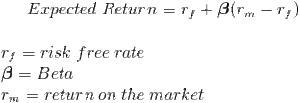Capital Asset Pricing Model (CAPM)
The capital asset pricing model (CAPM) is a model that describes the relationship between systematic risk and expected return for assets, particularly stocks. CAPM is widely used throughout finance for the pricing of risky securities, generating expected returns for assets given the risk of those assets and calculating costs of capital.[1]The CAPM was developed in the early 1960s by William Sharpe (1964), Jack Treynor (1962), John Lintner (1965a, b) and Jan Mossin (1966).
CAPM Formula[2]
Assumptions of CAPM[3]
All investors:
- Aim to maximize economic utilities (Asset quantities are given and fixed).
- Are rational and risk-averse.
- Are broadly diversified across a range of investments.
- Are price takers, i.e., they cannot influence prices.
- Can lend and borrow unlimited amounts under the risk free rate of interest.
- Trade without transaction or taxation costs.
- Deal with securities that are all highly divisible into small parcels (All assets are perfectly divisible and liquid).
- Have homogeneous expectations.
- Assume all information is available at the same time to all investors.
References
- ↑ What is the 'Capital Asset Pricing Model - CAPM Invetopedia
- ↑ Capital Asset Pricing Model - CAPM Formula Finance Formulas
- ↑ Capital Asset Pricing Model - CAPM Assumptions Wikipedia

